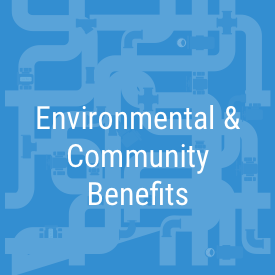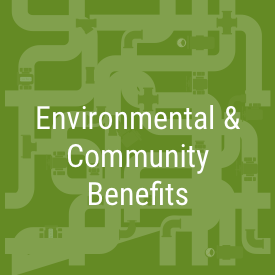This project enables Valley Water to work with local municipalities to clearly delineate and communicate roles and responsibilities for floodplain management and flood emergency management. The resulting plans will also strengthen response capabilities for mutual assistance during other types of public health and safety emergencies or natural disasters. The project supports Valley Water’s countywide emergency response, preparedness and mitigation activities, develops communication processes and disseminates web-based flood forecasting information developed under Project F7: Emergency Response Upgrades. Valley Water will also assist collaborating agencies in developing formal, site-specific flood-fighting strategies and will coordinate outreach throughout the county so that the public receives uniform warning messages during a flood emergency.








See Environmental & Community Benefits section for complete description of Key Performance Indicators (KPIs).
KPI #1: (Coordinate with local municipalities)
- Valley Water continues to attend the monthly Santa Clara County Emergency Managers meetings, where staff engages with Emergency Managers from local municipalities and shares Valley Water’s current work activities, particularly those involving collaboration with local agencies.
- Valley Water met with staff from the City of Milpitas to review the draft of the Lower Penitencia Creek Watershed Emergency Action Plan on September 28, 2023.
- On October 26, 2023, Valley Water’s Office of Emergency Service’s hosted a multijurisdictional Winter Preparedness Workshop. Attendees included emergency managers and public works representatives from local municipalities, the County, and state agencies. During this workshop the National Weather Service also provided the winter season outlook.
- On November 20, 2023, Valley Water met with the City of Palo Alto to kick off the planning of the 2023 San Francisquito Creek Multi-Agency Coordination group (SFC MAC group) exercise.
- On December 13, 2023, Valley Water met with the City of San Jose to do a walk-thru of the revised Joint Emergency Action Plan (JEAP) with an objective of familiarizing new staff on the use of the JEAP and to review updates that included the Anderson Dam retrofit, a new attachment - Guidance for Encampments of Individuals Located Within the Waterways, and a new appendix for Berryessa Creek.
- On December 14, 2023, Valley Water met with the South Santa Clara Fire District and CALFIRE Unit Chief along with members of the fire command staff to discuss ways to enhance communications and coordination between our two agencies as well as exploring possible partnership opportunities.
- Valley Water staff have developed Quick Guides for all our existing creek EAPs that have recently been updated or completed. These are five-to-seven-page summaries of an EAP. They are designed to provide easy access to the key actionable information from the full EAP.
KPI #2: (Flood Management Plans)
- In November 2023, Valley Water completed a draft Lower Penitencia Creek Watershed Emergency Action Plan that includes flood management plans for Berryessa Creek and Lower Penitencia Creek and met with the City of Milpitas to review. Following the review, the new EAP was approved that same month and posted to the Valley Water website.
- Prepared a draft update to the JEAP that includes a new Berryessa Creek Appendix.
- On December 13, 2023, Valley Water held a joint meeting with City of San José staff to review the 2023 draft update to the JEAP. This update included a new appendix providing guidance for encampments located within creeks and updated the Coyote Creek appendix to reflect the impact of the Anderson Dam retrofit project. Additionally, a Berryessa Creek Appendix was added.
- In January 2023, Valley Water completed minor updates to existing Emergency Action Plans for Lower Peninsula Watershed, West Valley Watershed, and Uvas Creek that included changes to website links, contact information, Valley Water stakeholders, public information flyers, minor flooding thresholds, and sandbag locations
- In January 2024, updates were completed to the West Little Llagas Creek EAP.
- All updated EAPs have been posted on the Valley Water website.
KPI #3: (Drills and exercises)
- In June 2023, Valley Water participated in an exercise hosted by CalFire and the South Bay Incident Management Team.
- The City of San José and Valley Water held a winter storm after action review in July 2023. This review focused on the effectiveness of the coordination between the two organizations as well as to identify lessons learned and innovations that can be incorporated in updates of the Joint Emergency Action Plan.
- In September 2023, Valley Water attended a meeting of the SFC MAC group, to review the San Francisquito Creek Multi-Agency Coordination Operational Plan (MAC plan) prior to the start of the rainy season and gather support for an exercise to be held in December.
- On November 30, 2023, Valley Water, in partnership with the City of Palo Alto, and the Menlo Park Fire Protection District conducted a tabletop exercise focused on the MAC plan. A tabletop exercise is a discussion-based exercise responding to a scenario intended to generate a dialogue about various issues, such as plans, policies, or procedures. The exercise was focused on enhancing the coordination between the multiple agencies that would be involved in response to a flooding event along San Francisquito Creek. Over 40 representatives from 16 organizations participated in the exercise. In addition to the organizations listed above, the Cities of Menlo Park, East Palo Alto along with Stanford University, Woodside Fire Protection District, National Weather Service, San Mateo County Flood and Sea Level Rise Resiliency District, and the San Francisquito Creek Joint Powers Authority participated in the exercise.
- Since December 2023, Valley Water and the City of Milpitas have been actively planning a joint tabletop exercise utilizing the Lower Penitencia Creek EAP. The exercise planning team included staff members from both Valley Water and the City of Milpitas. The exercise is scheduled for the middle of May.
KPI #4: (Effectiveness)
- On March 18th, Valley Water staff met with the San Francisquito Creek MAC group coordinator to review the draft of the November 2023 tabletop exercise After Action Report. An After-Action Meeting that will include representatives from all the organizations that participated in the exercise, will be held to review the report’s findings, and adopt an improvement plan based on the report’s findings.
April 2024
No current documents.
FY22-36 Key Performance Indicator for the Safe, Clean Water Program
-
Coordinate with local municipalities to merge Valley Water-endorsed flood emergency processes with their own emergency response plans and processes.
-
Complete five (5) flood management plans/procedures per 5-year period, selected by risk priorities.
-
Train Valley Water staff and partner municipalities annually on disaster procedures via drills and exercises before testing the plans and procedures.
-
Test flood management plans/procedures annually to ensure effectiveness.
Benefits
-
Reduces flood damage
-
Improves flood preparedness
-
Provides effective coordinated response to disaster-related emergencies
-
Improves community awareness about disaster-related risks
Geographic Area of Benefit
Countywide
About the Safe, Clean Water and Natural Flood Protection Program
In November 2020, voters in Santa Clara County overwhelmingly approved Measure S, a renewal of Valley Water’s Safe, Clean Water and Natural Flood Protection Program.
The program was first passed by voters in 2000 as the Clean, Safe Creeks and Natural Flood Protection Plan, then again in 2012 as the Safe, Clean Water and Natural Flood Protection Program. The renewal of the Safe, Clean Water Program will continue to provide approximately $47 million annually for local projects that deliver safe, clean water, natural flood protection, and environmental stewardship to all the communities we serve in Santa Clara County.
While evaluating ways to improve the 2012 program, Valley Water gathered feedback from more than 21,000 community members. That helped Valley Water create the six priorities for the renewed Safe, Clean Water Program, which are:
Priority A: Ensure a Safe, Reliable Water Supply
Priority B: Reduce Toxins, Hazards and Contaminants in our Waterways
Priority C: Protect our Water Supply and Dams from Earthquakes and Other Natural Disasters
Priority D: Restore Wildlife Habitat and Provide Open Space
Priority E: Provide Flood Protection to Homes, Businesses, Schools, Streets and Highways
Priority F: Support Public Health and Public Safety for Our Community
Each year, Valley Water prepares a report providing a progress update for each of these program priorities, along with fiscal year accomplishments.
To ensure transparency and accountability to the voters, the ballot measure also created an Independent Monitoring Committee, appointed by the Santa Clara Valley Water District Board of Directors. The Independent Monitoring Committee annually reviews the program’s progress to ensure the outcomes are achieved in a cost-efficient manner and reports its findings to the Board. Additionally, the IMC also reviews each proposed 5-year implementation plan prior to its submittal for Board approval.
In addition, the program requires three independent audits.


